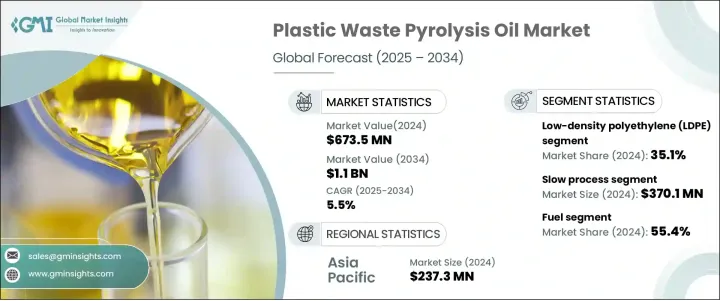PUBLISHER: Global Market Insights Inc. | PRODUCT CODE: 1716534

PUBLISHER: Global Market Insights Inc. | PRODUCT CODE: 1716534
Plastic Waste Pyrolysis Oil Market Opportunity, Growth Drivers, Industry Trend Analysis, and Forecast 2025 - 2034
The Global Plastic Waste Pyrolysis Oil Market generated USD 673.5 million in 2024 and is projected to grow at a CAGR of 5.5% between 2025 and 2034. This market is experiencing steady growth as industries and governments worldwide increasingly emphasize sustainable waste management solutions and seek alternative fuel sources to reduce dependence on fossil fuels. Plastic waste pyrolysis oil, derived from the thermal decomposition of plastic waste in an oxygen-free environment, is emerging as a viable solution for converting non-recyclable plastics into valuable fuels and feedstock. The increasing shift toward circular economy practices, aimed at minimizing waste and promoting resource efficiency, is driving market expansion. Pyrolysis oil is gaining traction due to its ability to reduce greenhouse gas emissions, improve energy efficiency, and support the growing demand for transport fuels, industrial heating oils, and petrochemical feedstock. With advancements in pyrolysis technologies enhancing process efficiency and reducing operational costs, the market for plastic waste pyrolysis oil is poised for significant growth.

The market is segmented based on feedstock, with low-density polyethylene (LDPE) holding the largest share at 35.1% in 2024. LDPE, widely used in packaging materials such as plastic bags and films, remains a prime candidate for pyrolysis due to its lower melting point and high yield efficiency. As LDPE waste is difficult to recycle through mechanical processes, the demand for chemical recycling methods like pyrolysis is increasing. LDPE-derived pyrolysis oil is becoming an attractive alternative fuel source, especially as governments implement stringent regulations on landfills and promote waste-to-energy systems to reduce environmental impact.
| Market Scope | |
|---|---|
| Start Year | 2024 |
| Forecast Year | 2025-2034 |
| Start Value | $673.5 Million |
| Forecast Value | $1.1 Billion |
| CAGR | 5.5% |
The plastic waste pyrolysis oil market is also classified by process type, with slow pyrolysis generating USD 370.1 million in 2024. Slow pyrolysis is the preferred method for producing pyrolysis oil because of its higher oil yield and stability. Operating at lower temperatures between 300-500°C and extended residence times, this process ensures more efficient thermal decomposition, resulting in increased liquid fuel production. It remains the most cost-effective option for large-scale commercial applications, making it a preferred choice for industries aiming to maximize yield while minimizing operational costs.
The Asia Pacific Plastic Waste Pyrolysis Oil Industry generated USD 237.3 million in 2024 and is expected to grow at a CAGR of 5.7% by 2034. The region's dominance is fueled by rapid industrialization, urbanization, and widespread plastic usage. Several countries across Asia Pacific are investing heavily in developing pyrolysis plants to address the rising issue of plastic waste. With a strong focus on waste-to-energy technologies and sustainable practices, the region is leading the global shift toward converting plastic waste into valuable resources. This increasing commitment to environmental sustainability and innovation in waste management continues to drive demand for plastic waste pyrolysis oil in Asia Pacific and beyond.
Table of Contents
Chapter 1 Methodology & Scope
- 1.1 Market scope & definition
- 1.2 Base estimates & calculations
- 1.3 Forecast calculation
- 1.4 Data sources
- 1.4.1 Primary
- 1.4.2 Secondary
- 1.4.2.1 Paid sources
- 1.4.2.2 Public sources
- 1.5 Primary research and validation
- 1.5.1 Primary sources
- 1.5.2 Data mining sources
Chapter 2 Executive Summary
- 2.1 Industry synopsis, 2021-2034
Chapter 3 Industry Insights
- 3.1 Industry ecosystem analysis
- 3.1.1 Factor affecting the value chain
- 3.1.2 Profit margin analysis
- 3.1.3 Disruptions
- 3.1.4 Future outlook
- 3.1.5 Manufacturers
- 3.1.6 Distributors
- 3.2 Supplier landscape
- 3.3 Profit margin analysis
- 3.4 Key news & initiatives
- 3.5 Regulatory landscape
- 3.6 Impact forces
- 3.6.1 Growth drivers
- 3.6.1.1 Favourable government initiatives
- 3.6.1.2 Rapid urbanization and industrialization
- 3.6.1.3 Increasing amount municipal solid waste (MSW)
- 3.6.2 Industry pitfalls & challenges
- 3.6.2.1 High production costs
- 3.6.1 Growth drivers
- 3.7 Growth potential analysis
- 3.8 Porter's analysis
- 3.9 PESTEL analysis
Chapter 4 Competitive Landscape, 2024
- 4.1 Introduction
- 4.2 Company market share analysis
- 4.3 Competitive positioning matrix
- 4.4 Strategic outlook matrix
Chapter 5 Market Size and Forecast, By Feedstock, 2021 – 2034 (USD Million, Tons)
- 5.1 Key trends
- 5.2 Low density polyethylene (LDPE)
- 5.3 High density polyethylene (HDPE)
- 5.4 Polypropylene (PP)
- 5.5 Others
Chapter 6 Market Size and Forecast, By Process, 2021 – 2034 (USD Million, Tons)
- 6.1 Key trends
- 6.2 Fast
- 6.3 Flash
- 6.4 Slow
Chapter 7 Market Size and Forecast, By End Use, 2021 – 2034 (USD Million, Tons)
- 7.1 Key trends
- 7.2 Fuel
- 7.3 Chemicals
- 7.4 Heat & power
- 7.5 Others
Chapter 8 Market Estimates and Forecast, By Region, 2021 – 2034 (USD Million) (Tons)
- 8.1 Key trends
- 8.2 North America
- 8.2.1 U.S.
- 8.2.2 Canada
- 8.3 Europe
- 8.3.1 Germany
- 8.3.2 UK
- 8.3.3 France
- 8.3.4 Spain
- 8.3.5 Italy
- 8.3.6 Netherlands
- 8.4 Asia Pacific
- 8.4.1 China
- 8.4.2 India
- 8.4.3 Japan
- 8.4.4 Australia
- 8.4.5 South Korea
- 8.5 Latin America
- 8.5.1 Brazil
- 8.5.2 Mexico
- 8.6 Middle East and Africa
- 8.6.1 Saudi Arabia
- 8.6.2 South Africa
- 8.6.3 UAE
Chapter 9 Company Profiles
- 9.1 Nexus Circular
- 9.2 OMV Aktiengesellschaft
- 9.3 Niutech Environment Technology Corporation
- 9.4 Klean Industries
- 9.5 Fortum OyJ
- 9.6 Enerkem
- 9.7 Ensyn Corporation
- 9.8 Twence B.V.
- 9.9 Agilyx Corporation
- 9.10 Green Fuel Nordic Corporation
- 9.11 Vadxx Energy LLC
- 9.12 Quantafuel AS
- 9.13 RESYNERGI
- 9.14 JBI Inc.




